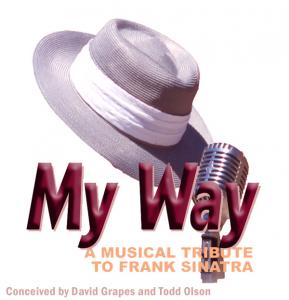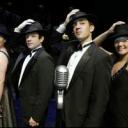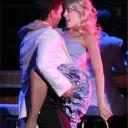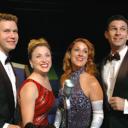
Video
Authors
Photos
Plot / Synopsis
The Songs in My Way: A Musical Tribute to Frank Sinatra
All of Me
By Gerald Marks (1900-1997) and Seymour B. Simons (1896-1949). Published in 1931. Originally in the film Careless Lady, starring Joan Bennett. Sinatra recorded the song three times: first in 1946, and the second time in his film Meet Danny Wilson (also starring Shelley Winters), which was released in 1951. The third recording appeared on Sinatra's Swing Easy, 1955. The song was originally a #1 hit by Louis Armstrong in 1932.
All the Way
By Sammy Cahn (1913-1995) and Jimmy Van Heusen (1913-1990). Published in 1957. An Academy Award-winning song from the film, The Joker Is Wild, starring Sinatra and Mitzi Gaynor. The song was recorded twice by Sinatra: the first recording appeared on All The Way (1960), the second on Sinatra's Sinatra (1963).
The Best is Yet to Come
By Cy Coleman (b. 1929) and Carolyn Leigh (1926-1983). Published in 1961. First appeared on Sinatra's It Might As Well Be Swing in 1964. Previously a hit for Mabel Mercer, Peggy Lee, Sarah Vaughn, and Tony Bennett.
Can I Steal a Little Love?
By Phil J. Tuminello. Published in 1956. Recorded by Sinatra in 1956, and appeared on his album, Forever Frank. The song was also used in the film Rock, Pretty Baby, starring Sal Mineo.
Chicago
By Fred Fisher (1875-1942). Published in 1922. Recorded by Sinatra in 1957, and used in his film, The Joker Is Wild. The song first appeared on the album, Come Fly With Me. Previously a vaudeville song sung by Blossom Seeley.
Dindi (Pronounced JinJee)
By Aloysio De Oliveira(1914-1995), Ray Gilbert (d. 1976) and Antonio Carlos Jobim (1927-1994). Published in 1966. First appeared on Sinatra's Francis Albert Sinatra & Antonio Carlos Jobim, a collaboration between Sinatra and the foremost Brazilian interpreter of bossa nova music.
Dream
By John H. Mercer (1909-1976). Published in 1944. Originally heard in the film, Her Highness And The Bellboy, starring Hedy Lamarr and was the closing theme song to composer Johnny Mercer's radio show. Sinatra recorded it
twice: the first in 1945 (with the Ken Lane Singers), and the second time in 1960, which appears on Nice N' Easy.
Drinking Again
By John H. Mercer(1909-1976) and Doris Tauber. Published in 1962. Recorded as a single in 1967. Appears on the album, The World We Knew.
Fly Me to the Moon
By Bart Howard (b. 1915). Published in 1954. First recorded by Sinatra (with Count Basie) on his It Might as Well Be Swing album.
Guess I'll Hang My Tears Out to Dry
By Sammy Cahn (1913-1995) and Jule Styne (1905-1994). Published in 1944. From the failed Broadway musical, Glad To See You (closed in Boston). Sinatra recorded this song twice: first in 1946 (on The Essential Frank Sinatra, Volume 2 album) and again in 1958 for his album, Frank Sinatra Sings For Only The Lonely.
Here's to the Losers
By Jack Segal and Robert Wells. Published in 1963. First recorded by Sinatra on his Softly As I Leave You album.
High Hopes
By Sammy Cahn (1913-1995) and Jimmy Van Heusen(1913-1990). Published in 1959. From the Frank Capra film, A Hole in The Head, which starred Sinatra, Edward G. Robinson and Eleanor Parker. It won the Academy Award for Best Song and was used by John F. Kennedy in his campaign for President. It first appeared on Sinatra's All The Way album.
How About You? (I Like New York In June)
By Ralph Freed (1907-1973) and Burton Lane (1912-1997). Published in 1941. Written for Judy Garland for the film, Babes On Broadway. Sinatra recorded this song twice: the first with The Tommy Dorsey Orchestra in 1941, and again in 1956 for his album, Songs For Swingin' Lovers.
I Believe
By Sammy Cahn (1913-1995)and Jule Styne (1905-1994). Published in 1946. From the film It Happened in Brooklyn, which starred Sinatra, Jimmy Durante, and Kathryn Grayson. Sinatra recorded this song twice: first in 1946 for the aforementioned film, and again in 1957. The second recording appeared on This Is Sinatra, Volume 2.
I Get a Kick Out of You
By Cole Porter (1891-1964). Published in 1934. Originally sung by Ethel Merman in the Broadway smash Anything Goes. Sinatra first recorded this song in 1953, and it can be found on his album, Songs For Young Lovers. Sinatra recorded it again in 1962 for the album, Sinatra And Swingin' Brass.
I Love Paris
By Cole Porter (1891-1964). Published in 1953. From the Broadway musical Can-Can. Sinatra starred in the 1960 film version of Can-Can along with Shirley MacLaine and Maurice Chevalier. Sinatra first recorded this song as a duet with Chevalier for the Can-Can soundtrack. He recorded it a second time for his album, Frank Sinatra Sings Of Love And Things.
I Only Have Eyes for You
Al Dubin (1891-1945) and Harry Warren (1893-1981). Published in 1934. Written for the Busby Berkley film extravaganza, Dames, which starred Dick Powell and Ruby Keeler. Sinatra first recorded this song on a 1945 V-Disc, the only recordings made during World War II. It was shipped for military use only. Sinatra recorded it a second time with Count Basie in 1962 for Sinatra And Basie. The Sinatra V-Discs were first released for commercial sale in 1994. The first hit recording was made by Ben Selvin And His Orchestra in 1934.
I'll Be Seeing You
By Sammy Fain (1902-1989) and Irving Kahal (1903-1942). Published in 1938. The song was introduced in the Broadway show, Right This Way. Sinatra originally recorded this song in 1940 with The Tommy Dorsey Orchestra but it didn't become a hit record until it was re-released in 1944. Sinatra recorded the song again in 1961 for his album, I Remember Tommy.
I'm Gonna Live Til I Die
By Al Hoffman (1902-1960), Walter Kent (b. 1911), and Mann Curtis (1911-1984). Published in 1954. Recorded by Sinatra in 1954 as a single and was first on his Forever Frank album. The song was used in the 1957 film musical, This Could Be The Night, which starred Jean Simmons and Anthony Franciosa.
Indian Summer
By Al Dubin (1891-1945) and Victor Herbert (1859-1924). Published in 1919 as a piano piece by Herbert. Al Dubin added lyrics to the song in 1939. Recorded by Sinatra in 1967 for the album, Francis A., Edward K. (Duke Ellington). This song was a big #1 hit for Tommy Dorsey before he hired Sinatra.
It Was a Very Good Year
By Ervin M. Drake (b.1919). Published in 1961. Recorded by Frank Sinatra in 1965 and can be found on the September Of My Years album. This song can be heard as a recurring song on HBO's The Sopranos.
It's All Right With Me
By Cole Porter (1891-1964). Published in 1953. From the Broadway musical, Can-Can. Sinatra starred in the 1960 film version of Can-Can, the year he was named Top Box Office Star by the Film Exhibitors of America. Sinatra recorded this song twice: the first for the Can-Can soundtrack, and the second in 1984 for the L.A. Is My Lady album.
I've Got the World on a String
By Harold Arlen (1905-1986) and Ted Koehler (1894-1973). Published in 1932. Recorded by Sinatra in 1953 as a single. It first appeared on the 1957 album, This Is Sinatra. The original 1933 recording was by Cab Calloway.
I've Got You Under My Skin
By Cole Porter (1891-1964). Published in 1936. From the film musical Born To Dance, starring Eleanor Powell and Jimmy Stewart. It was first recorded by Sinatra in 1956 for the album, Songs For Swingin' Lovers. Sinatra recorded it a second time in 1963, and it appeared on the album, Sinatra's Sinatra. This song was one of Sinatra's most requested tunes.
L.A. is My Lady
By Alan Bergman (b. 1925), Marilyn Bergman (b. 1929), Quincy D. Jones (b.
1933) and Peggy Lipton (b. 1948). Published in 1984. This is the title song from Sinatra's 1984 album.
The Lady is a Tramp
By Richard Rodgers (1902-1979) and Lorenz Hart (1895-1943). Published in 1937. From the Broadway hit, Babes In Arms. The song was added to the 1957 film version of Rodger's and Hart's Pal Joey, which starred Sinatra, Rita Hayworth and Kim Novak. It can be found on the Pal Joey soundtrack album.
Lean Baby
By Roy Alfred and William May (b. 1916). Published in 1953. Sinatra recorded this song in 1953 at his first recording session at Capitol Records. It appeared on his first Capitol album, Swing Easy.
Let's Face the Music and Dance
By Irving Berlin (1888-1989). Published in 1936. First seen in the Fred Astaire, Ginger Rogers film, Follow The Fleet. Sinatra recorded this song
twice: first in 1960 for the album, Ring-A-Ding-Ding, and the second time in 1979 for the Trilogy series. It was found on Record One - The Past.
Let's Get Away From It All
By Thomas Montgomery Adair and Matt Dennis (b. 1914). Published in 1940. Sinatra recorded this song twice: first with Tommy Dorsey (along with the Pied Pipers and Connie Haines) and the second time in 1957 for the album, Come Fly With Me.
Love and Marriage
By Sammy Cahn (1913-1995) and Jimmy Van Heusen(1913-1990). Published in 1955. Written for the Emmy-award winning musicalized television production of Thornton Wilder's Our Town, which also starred Paul Newman and Eva Marie Saint. The song first appeared on This Is Sinatra (1957). The song is now recognized as the theme song to the 90's sitcom Married With Children. Sinatra rerecorded the song in 1965 for the album, A Man And His Music.
Makin' Whoopee
By Walter Donaldson (1893-1947) and Gus Kahn (1886-1941). Published in 1928. Written for Eddie Cantor for Ziegfeld's Broadway production of Whoopie. Recorded by Sinatra in 1956 for the album, Songs For Swingin' Lovers.
Moonlight Serenade
By Glenn Miller (1904-1944) and Mitchell Parish (1900-1993). Published in 1939. Recorded by Sinatra in 1965 for the album, Moonlight Sinatra. This song was bandleader Glenn Miller's theme song.
My Funny Valentine
By Richard Rodgers (1902-1979) and Lorenz Hart (1895-1943). Published in 1937. From the Broadway hit, Babes In Arms. Recorded by Sinatra for the 1953 album, Songs For Young Lovers.
My Kind of Town
By Sammy Cahn (1913-1995) and Jimmy Van Heusen (1913-1990). Published in 1964. Written for Sinatra for the 1964 film, Robin and the Seven Hoods, which also starred Rat Packer's Dean Martin, Sammy Davis, Jr., and Bing Crosby. It was originally heard on the My Kind Of Town soundtrack.
My Way
By Paul Anka (b.1941), Gilles Thibault (1927-2000), Claude Francois (1939-1978), and Jacques Revaux (b. 1945). Published in 1967. Originally written in French as "Comme d'Habitude" ("As Usual"). The song first appeared on the 1969 Sinatra album, My Way. This song was one of Sinatra's most popular and most requested songs.
(Theme From) New York, New York
By John Kander (b. 1927) and Fred Ebb (b. 1933). Published in 1977. Written for the film of the same title, which starred Robert DeNiro and Liza Minnelli. Sinatra recorded it in 1979 for the second album in his Trilogy series, Record Two - The Present. It became one of Sinatra's most performed songs.
Nice N' Easy
By Alan Bergman (b. 1925), Marilyn Bergman (b. 1929) and Lew Spence. Published in 1960. Recorded by Sinatra for the 1960 album, Nice N' Easy.
On the Sunny Side of the Street
By Dorothy Fields (1905-1974) and Jimmie McHugh (1894-1969). Published in 1930. The song is from the Broadway show, International Revue, which starred Gertrude Lawrence. Sinatra recorded this song in 1961, and it appeared on the album, Come Swing With Me. The first recording was made by Ted Lewis And His Orchestra in 1930.
One For My Baby (And One More For The Road)
By Harold Arlen (1905-1986) and John H. Mercer (1909-1976). Published in 1943. This song was originally sung by Fred Astaire in the film, The Sky's The Limit. Sinatra recorded this twice: the first in 1947, and the second in 1958 for the album, Frank Sinatra Sings For Only The Lonely. The first singer to have a hit record with this song was Lena Horne in 1945.
The Same Old Song and Dance
By Sammy Cahn (1913-1995), Jimmy Van Heusen (1913-1990), and Bobby Worth. Published in 1958. Recorded in 1958 for the album Come Dance With Me.
Should I?
By Nacio Herb Brown (1896-1964) and Arthur Freed (1894-1973). Published in 1930. Originally written for the film, Lord Byron of Broadway, starring Charles Kaley. Sinatra recorded this song twice: the first in 1950 for the Love Is A Kick album, and again in 1960 for the album, Sinatra's Swingin' Session.
Something Stupid
By C. Carson Parks. Published in 1967. This song was a duet with Sinatra and his daughter Nancy. First appeared on Sinatra's 1967 album, Frank Sinatra.
Something Wonderful Happens in Summer
By Joseph Bushkin (b. 1916) and John De Vries. Published in 1956. Sinatra recorded this song in 1957, and it appears on the 1958 album, This Is Sinatra, Volume 2.
South of the Border (Down Mexico Way)
By Michael Carr (d. 1968) and James B. Kennedy (1902-1984). Published in 1939. Originally a huge #1 hit by Shep Fields & His Rippling Rhythm Orchestra. Sinatra recorded it in 1953, and it appeared on his 1957 album, This Is Sinatra.
Strangers in the Night
By Bert Kaempfert (1923 - 1980), Charles Singleton, and Eddie Snyder. Published in 1966. Sinatra recorded this song in 1966, and it appears on his Strangers In The Night album. Sinatra, at first, hated this song and didn't want to sing it. It became one of his most popular songs.
Summer Wind
Hans Bradtke, Heinz Meier (Henry Mayer), and John H. Mercer (1909-1976). Published in 1965. The song was originally written in German: Mercer translated Bradtke's lyrics. Sinatra recorded it in 1966, and it appeared on the album Strangers In The Night.
That Old Black Magic
By Harold Arlen (1905-1986) and John H. Mercer (1909-1976). Published in 1943. Originally written for the film, Star Spangled Rhythm, starring Betty Hutton, and it was a huge #1 hit for Glenn Miller & His Orchestra. Sinatra recorded it twice: in 1946 and in 1961. The first version appears on The Voice, while the second appears on Come Swing With Me.
That's Life
By Kelly L. Gordon and Dean K. Thompson. Published in 1966. Sinatra recorded the song in 1966 and it first appeared on his 1966 album, That's Life.
(Love Is) The Tender Trap
By Sammy Cahn (1913-1995) and Jimmy Van Heusen (1913-1990). Published in 1955. Written for the film, The Tender Trap, which starred Sinatra and Debbie Reynolds. Sinatra recorded this song twice: in 1955 and in 1962. The first appeared on This Is Sinatra, the second on Sinatra And Basie.
The Way You Look Tonight
By Jerome Kern (1885-1945) and Dorothy Fields (1905-1974). Published in 1936. This Academy Award-winning song was originally sung by Fred Astaire and Ginger Rogers in the film Swing Time. Sinatra recorded the song in 1964 and it appeared on Frank Sinatra Sings Days Of Wine And Roses, Moon River, And Other Academy Award Winners.
This is All I Ask
By Gordon Jenkins (1910-1984). Published in 1965. Sinatra recorded this song in 1965 for the album, September of My Years.
Wave
By Antonio Carlos Jobim (1927-1994). Published in 1968. Sinatra recorded this song in 1969 for 1970 album, Sinatra And Company.
Where or When
By Richard Rodgers (1902-1979) and Lorenz Hart (1895-1943). Published in 1937. From the Broadway musical, Babes In Arms. It was originally a big #1 hit for Hal Kemp & His Orchestra in 1937. Sinatra recorded it twice: the first in 1945, which appeared on the album The Voice, and the second in 1958, which appeared on Frank Sinatra Sings Songs For Only The Lonely.
Witchcraft
By Cy Coleman (b. 1926) and Carolyn Leigh (1926-1983). Published in 1957. Sinatra recorded this song twice: first as a single (which appeared on the 1960 compilation album, All The Way), and second in 1963, which appeared on Sinatra's Sinatra.
You Go to My Head
By J. Fred Coots (1897-1985) and Haven Gillespie (1888-1975). Published in 1938. Sinatra recorded this song twice: in 1945, and in 1960. The first appeared on Frank Sinatra Story In Music, and the second appeared on Nice N' Easy.
You Make Me Feel So Young
Mack Gordon (1904-1959) and Josef Myrow (1910-1987). Published in 1946. From the film, Three Little Girls In Blue, starring June Haver and Celeste Holm. Sinatra recorded this song in 1956, and it appeared on the album, Songs For Swingin' Lovers.
Young at Heart
Carolyn Leigh (1926-1983) and Johnny Richards. Published in 1953. Sinatra recorded this song as a single, and it first appeared on the 1957 album, This Is Sinatra. The song inspired a movie of the same title, which starred Sinatra and Doris Day.
You're Cheatin' Yourself (If You're Cheatin' On Me)
Al Hoffman (1902-1960) and Dick Manning. Sinatra recorded this song in 1957 and it appeared on This Is Sinatra, Volume 2.
Cast
Man #1 is aged 40-60 and should have a dark Italian look (the "Rat Pack" years). Man #1 must have a deep/rich strong velvety baritone voice in the Sinatra mode. He sings many of the Sinatra standards, so he needs to have an incredible vocal instrument and have a feel for Sinatra's unusual phrasing and distinctive vocal style. He should dance or at the very least move extremely well. Tap dance skills are a big plus as there are a number of optional tap/dance breaks written for this character. Man #1 should also be able to sing close harmony. Ideally, this actor projects the style and easy sophistication that was the Sinatra trademark WITHOUT DOING ANY SORT OF PHYSICAL OR VOCAL IMITATION of the man. He is the leader of the ensemble in terms of setting the tone and style that the show's music demands. Finally, he must relate well to the audience and possess the charisma to bring them along on this two hour musical journey into the world of "cool." This is the "key" casting decision and will be the most difficult performer to locate and cast.
Man #2 25-40 Is the skinny 1940's big band "crooner" look. This actor should have all American boy good looks and be a physical contrast to the actor playing Man #1. He should have a strong legit lyric baritone voice and be an excellent part singer. He sings up to a G. Listen to the Sinatra recordings with the Tommy Dorsey Orchestra to understand the smooth easy vocal style that is required for this role. Man #2 should also have a natural and unaffected flair for comedy as he carries much of the show's humor and lighter moments. He spends much of the show trying to learn how to be "cool." He is matched with Woman #2 and they need to look great as a pair. Moves well.
Woman #1 30-50 should have dark, sensual, exotic, and striking good looks. In some ways, her character represents the female version of Frank ("Rat Pack" period). She is a "classy dame" who drips with style, sophistication, and class. Woman #1 has the more difficult singing role of the two women. Vocally she is a strong mezzo soprano who can also belt. Her vocal style is based on great "torch singers" like Ella Fitzgerald, Lena Horne, and Judy Garland. In other words, she performs with "balls." This actress sings through a wide range vocally and must also be a capable part singer. A dark, smoky, husky sound is preferred. This actress must look good and match up well physically with Man #1. One of the two women should be a strong dancer and the other move well.
Woman #2 20-35 must be a leggy blonde or redhead with drop dead looks and a smile that lights up the room. She should be able to project an energetic and youthful sexuality to the audience. Woman #2 is the type of woman that always attracted Frank (aka Marilyn Monroe, Ava Gardner, Mia Farrow, etc). Vocally this character needs to have that same smooth liquid big band singer sound of the 40's that Man #2 should also possess. Woman #2 is also a mezzo but does sing some soprano parts. Her voice should be lighter and provide a contrast to the darker sound required for Woman #1. She too needs to be a capable part singer. For this role a strong dancer with tap skills would be a big plus. In the original production, Man #1 and Woman #2 were both outstanding tap dancers. Woman #2 matches up physically with Man #2 and the two of them should make a handsome couple.





